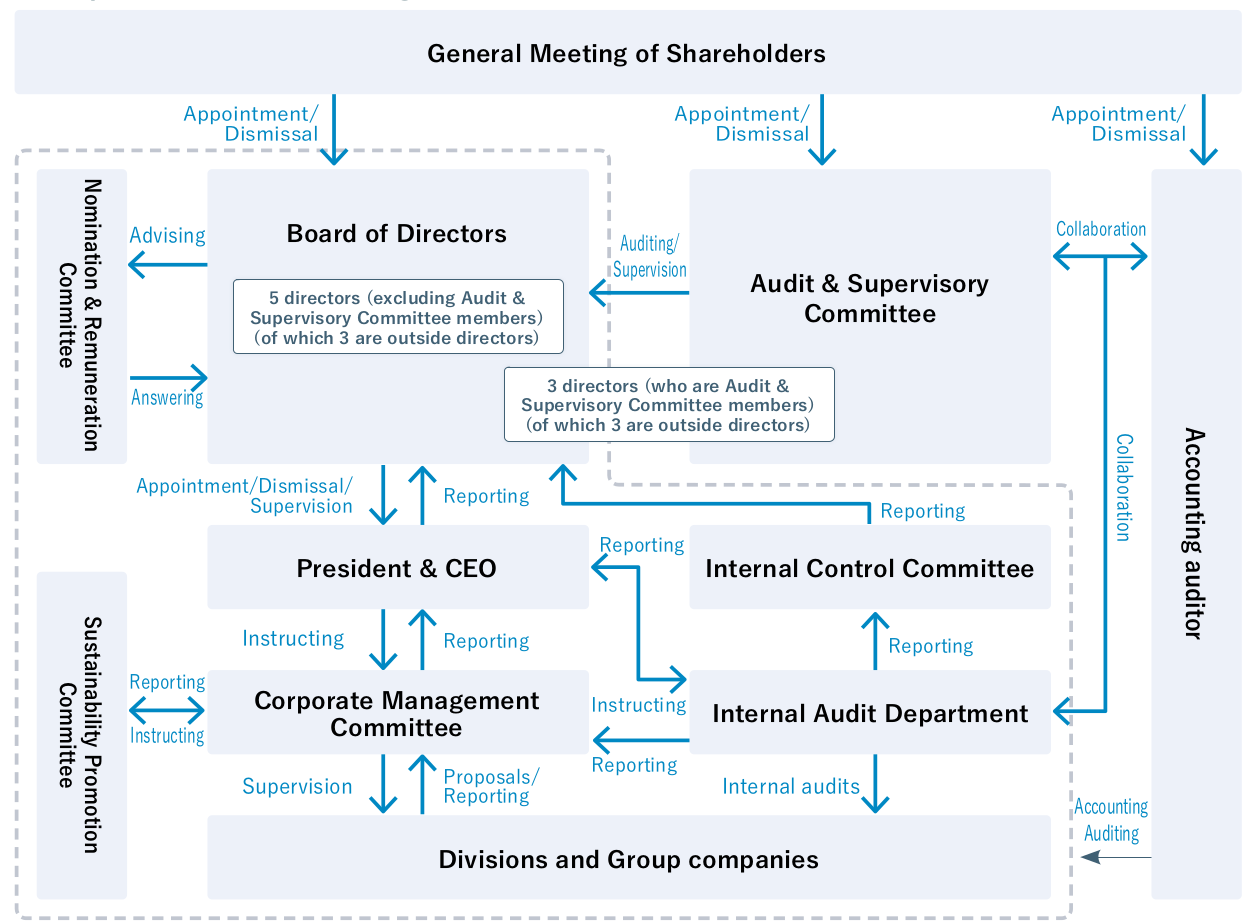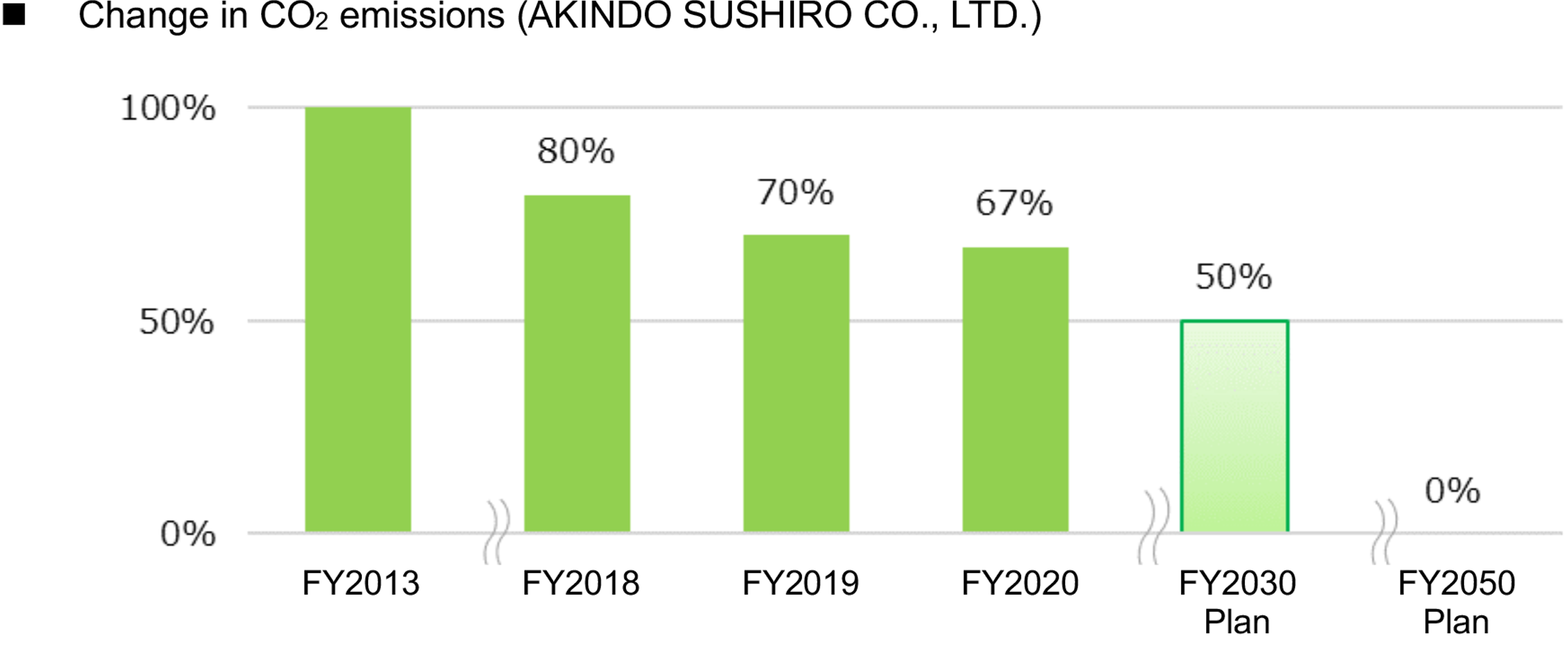Disclosure Based on TCFD Recommendations
Response to TCFD Recommendations
Our Group’s VISION is “Discovering new tastiness, Sharing moments of joy.” In order to continue to provide safe and delicious food to our customers, it is essential to take sustainable initiatives with an eye to the future in our business activities. In particular, since our Group uses a wide variety of marine, fishery, agricultural and forestry resources as raw materials, we position climate change as one of our major management risks and will disclose information related to climate change based on the recommendations of the Task Force on Climate-related Financial Disclosures (TCFD).
Governance
The Group’s Board of Directors recognizes climate change issues as one of its important management issues and is overseeing them. Specifically, when formulating business strategies and business plans, the Board of Directors deliberates on the “risks” and “opportunities” related to climate change issues, and receives reports from each Group company and department as necessary and performs oversight.
In addition, the Group has clearly positioned sustainability as a management issue for the entire Group, and has established a Sustainability Promotion Committee chaired by the President and CEO to promote sustainability initiatives. The Sustainability Promotion Committee will report on the status of sustainability, including climate change responses, to the Management Meeting as appropriate and receive instructions and advice. Furthermore, the President and CEO will report on the status to the Board of Directors as necessary.

Strategy
Based on the framework recommended by the TCFD recommendations, the Group has identified the risks and opportunities that climate change poses to the Group and conducted an analysis using different climate-related scenarios. Going forward, the Group will continue to further deepen its analysis of risks and opportunities in order to minimize risks and maximize opportunities toward the realization of a decarbonized society.
In the scenario analysis, we extracted the risks to our group related to climate change and conducted a scenario analysis on those that are expected to have a particularly large impact on our group. Based on the results of the scenario analysis, we organized the necessary measures to minimize risks and maximize opportunities. In particular, we conducted a detailed analysis of the impact of climate change on raw material procurement, which is expected to be the most important for our group’s business continuity, based on fish species, production areas, etc.
Prerequisites for Scenario Analysis
In addition to identifying physical risks, transition risks, and business opportunities related to climate change, the Group evaluates the impact of these climate change risks and opportunities on its business strategies and financial plans. The scenario analysis targeted Akindo Sushiro Co., Ltd. (domestic), the Group’s core business, and the time frame selected was 2030 for transition risks and 2050 for physical risks. In addition, scenario analysis was conducted using a below 2°C scenario and a 4°C scenario based on scenarios such as the Sustainable Development Scenario by the IEA (International Energy Agency) and Shared Socioeconomic Pathways 5-8.5 by the IPCC (Intergovernmental Panel on Climate Change).
Scenario Analysis Results
The main risks and opportunities for our Group in the below 2°C scenario include the strengthening of regulations and policies toward a decarbonized society, changes in consumer preferences, and the transition to a circular economy. Specifically, we expect increases in store operation and procurement costs due to rising energy procurement costs caused by the introduction of carbon pricing, as well as increases in costs due to plastic regulations and strengthened food waste measures. Our Group will actively implement measures such as the introduction of renewable energy and a shift to clean energy, decarbonizing energy through the introduction of energy-saving equipment, and switching from plastic containers to paper containers, while also promoting deplasticization through the consideration of the introduction of recycling and recyclable resources, and contributing to a circular economy through the consideration of the introduction of recycling food waste such as leftovers into feed and biomass fuel, thereby minimizing risks and aiming to expand business opportunities through differentiation.
In addition, the 4°C scenario assumes that as temperatures continue to rise, physical risks such as more severe natural disasters, rising average temperatures, and changes in weather patterns will become apparent. Specifically, the impact of more severe natural disasters on the Group’s store operations and supply chain, and the impact of rising average temperatures and changes in weather patterns on ecosystems will become apparent, affecting the Group’s procurement of raw materials. The Group will minimize risks by considering responses to physical risks when developing and operating stores, and will ensure the resilience of its supply chain through initiatives such as diversifying its procurement network.
The risks and opportunities identified in each scenario will be shared with the Sustainability Promotion Committee and the Internal Control Committee, and appropriate responses will be taken to ensure the Group’s resilience to climate change risks while maximizing the opportunities. We will continue to respond to climate change through scenario analysis, refining the impact of financial impacts, and concretely reflecting risks, opportunities, and countermeasures in our management plans.
Financial Impact and Countermeasures
Financial Impact and Countermeasures
We conducted a survey and analysis of the impact of climate change on major raw materials that are considered to have a large impact on our group, based on reports from various research institutes and academic papers. The table below shows the results of an assessment of the outlook for procurement environments and resource volumes for tuna, yellowtail, sea bream, shrimp, salmon, and rice, which are commonly used as sushi toppings.
As for fish, one of the main food ingredients, we divided each fish species into main procurement regions and wild/farmed, and conducted literature research on each. Although there are some differences in production areas, because the difference in temperature rise will become larger from 2050 onwards, we made common trend predictions up to 2050 for both the 2°C and 4°C scenarios, but after 2050, we separately predicted trends for the 2°C scenario and the 4°C scenario. As a result, we concluded that there is a low risk of a rapid decline in landings and production of each fish species and rice until 2050.
On the other hand, the report concluded that it is difficult to deny the possibility that, under the 4°C scenario, rising sea temperatures will have varying degrees of adverse effects on each fish species from 2050 onwards.
Regarding rice, there are concerns that a decline in quality due to rising temperatures in both the 2°C and 4°C scenarios could lead to risks to the procurement of high-quality rice.
Based on the above evaluation, we have considered the direction of measures to stabilize procurement. For all raw materials, we will promote the development and use of advanced farming and cultivation techniques that are suited to climate change (see “Initiative ②” below for an example), while at the same time considering overseas farming projects for tuna, yellowtail, and sea bream in addition to the current domestic ones, and for shrimp and salmon, we will explore new countries for procurement and develop new farming techniques. For rice, we will select production areas and varieties that are suited to climate change, and support breeding projects to ensure quality.
Specific Initiatives to Address Climate Change Risks

Initiative 1: Installation of Solar Power Generation Equipment in Stores
We are currently installing solar power generation equipment in our street-front stores using solar PPAs. As of August 2023, we have installed solar power generation equipment in over 80 stores, and will continue to do so in the future. In addition, we are considering installing additional equipment in existing stores and installing the equipment when opening new stores.

Initiative 2: Strengthening Support for the Aquaculture Industry and Diversifying and Stabilizing Procurement through the Use of Food Tech
In preparation for the risk of unstable fish supply due to climate change, we have strengthened our support for the aquaculture industry. Specifically, together with Owase Bussan Co., Ltd., in which we have invested, we are developing and establishing aquaculture techniques and researching feeding methods.
We are also working on improving fish varieties using advanced food tech such as biotechnology and genome editing technology. In addition, in April 2022, we established “Marineverse Co., Ltd.” in collaboration with Takuyo Co., Ltd. with the aim of stable production and utilization of marine resources, and are conducting research and development of farmed fish seeds and feed.

Initiative 3: Contributing to Climate Change Measures through Efficient Use of Resources
The edible oil used at Sushiro and Sugidama is supplied as a raw material for domestically produced sustainable aviation fuel, SAF (Sustainable Aviation Fuel).
By reusing waste cooking oil to produce domestically produced SAF, we aim to realize a circular economy that contributes to combating climate change through the effective use of resources.
Risk Management
Our Group’s Sustainability Promotion Committee plays a central role in identifying, analyzing, and evaluating climate-related risks. The Sustainability Promotion Committee is chaired by the Representative Director and President, and requests each Group company and department to formulate and report on countermeasures for the climate change-related risks that it has identified, analyzed, and evaluated, as appropriate and necessary.
In addition, in order to identify all risks that threaten the continued development of the company and to establish a risk management system, the Group has established “Risk Management Regulations” and established an Internal Control Committee. The Internal Control Committee will identify, analyze, and evaluate important risks to the Group’s management, and will develop remedial measures, among other measures, to establish a system for appropriate crisis management. The Sustainability Promotion Committee and the Internal Control Committee will also work together to address climate change-related risks.
Indicators and Goals
Our Group prioritizes reducing CO2 emissions from our core business of operating sushi restaurants in Japan, and has set the following CO2 emission targets for Akindo Sushiro Co., Ltd.
- FY2030: Reduce CO2 emissions (Scope 1 + 2) by 50% or more per unit compared to FY2013
- FY2050: Carbon neutral
The Group believes that in order to combat climate change, it is important not only to reduce CO2 emissions from our business activities, but also to develop technologies and promote businesses that contribute to reducing CO2 emissions in society, and will work on this issue across the entire Group.

Note: Based on emissions per unit of sales (denominator: 1 million yen). Ratio assuming FY2013 CO2 emissions as 100.
CO2 emissions in fiscal 2013 were 63,311 tons-CO
